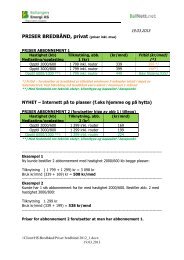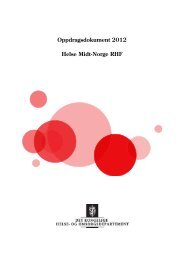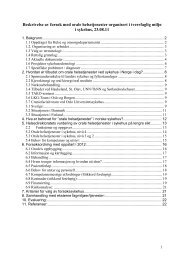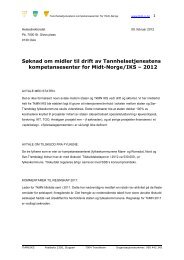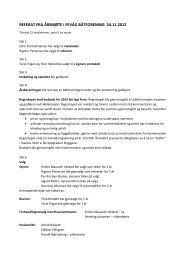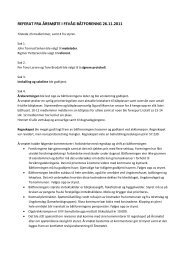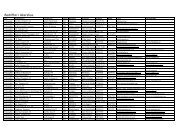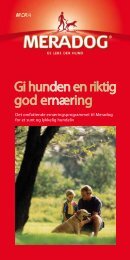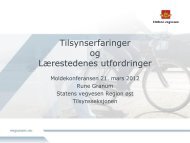Oral Health in Norway. The HUNT Study.
Oral Health in Norway. The HUNT Study.
Oral Health in Norway. The HUNT Study.
You also want an ePaper? Increase the reach of your titles
YUMPU automatically turns print PDFs into web optimized ePapers that Google loves.
Protocol 11.9.2011<br />
<strong>Oral</strong> <strong>Health</strong> <strong>in</strong> <strong>Norway</strong>.<br />
<strong>The</strong> <strong>HUNT</strong> <strong>Study</strong>.<br />
Prof. Dorthe Holst<br />
Odontologisk fakultet<br />
UiO<br />
Kari Strand<br />
Fylkestannlege<br />
Nord-Trøndelag Fylkeskommune<br />
Tannhelsetjenestens kompetansesenter Midt-Norge<br />
Ste<strong>in</strong>ar Krokstad<br />
<strong>HUNT</strong> forskn<strong>in</strong>gssenter<br />
Institutt for samfunnsmedis<strong>in</strong><br />
NTNU<br />
Ste<strong>in</strong>ar.Krokstad@ntnu.no
Background<br />
<strong>The</strong> oral health studies <strong>in</strong> Trøndelag<br />
<strong>Oral</strong> health may obviously be associated with many other health factors. But data on<br />
oral health was for the first time collected <strong>in</strong> a general health survey <strong>in</strong> <strong>Norway</strong> <strong>in</strong> the <strong>HUNT</strong><br />
<strong>Study</strong> 2006-08 ( <strong>HUNT</strong>3). Thus, this new jo<strong>in</strong>t <strong>in</strong>itiative between the <strong>HUNT</strong> Research Centre,<br />
Faculty of Medic<strong>in</strong>e NTNU and the Odontological Faculty Oslo University, opens up new<br />
opportunities. And due to that <strong>HUNT</strong> is population based and data is collected <strong>in</strong> 24<br />
municipalities, oral health <strong>in</strong> the general population aged 20-100 years old may be mapped.<br />
However, both questionnaire and cl<strong>in</strong>ical data have been collected <strong>in</strong> <strong>Norway</strong> earlier, as<br />
part of the first WHO International Collaborative <strong>Study</strong> (WHO ICS-I) <strong>in</strong> 1973 (1). In 1983,<br />
1994 and <strong>in</strong> 2006 oral health has been exam<strong>in</strong>ed aga<strong>in</strong> <strong>in</strong> random samples of the same birthcohorts<br />
that were selected <strong>in</strong> 1973 (11) (Figure 1). An analysis with<strong>in</strong> 1983 showed that<br />
social <strong>in</strong>equality <strong>in</strong> oral health was found <strong>in</strong> 13-14 year olds, and the <strong>in</strong>equality <strong>in</strong>creased <strong>in</strong><br />
the older adult age-groups assessed cross-sectionally (2). Schuller (1999) analysed whether<br />
the oral health improvement from 1983 to 1994 among 23-24 olds <strong>in</strong> Trøndelag was equally<br />
distributed among high and low social status groups (2). Schuller found that improved oral<br />
health was accompanied by more <strong>in</strong>equality among young adults. In the present study it has<br />
been possible to follow samples of two birth-cohorts (1959-1960 and 1929-1938) and samples<br />
of 35-44 year olds <strong>in</strong> time series for more than 30 years (Table 1).<br />
Figure 1. <strong>The</strong> basic design of the <strong>Oral</strong> <strong>Health</strong> Trøndelag studies<br />
Age 1973 1983 1994 2006 (<strong>HUNT</strong>3)<br />
13-14 X X<br />
23-24 X X<br />
33-34 X<br />
35-44 X X X X (+46,47)<br />
45-54 X X<br />
55-64 X<br />
68-77 X
At the start of the 21 st century, all European countries are faced with substantial<br />
<strong>in</strong>equalities <strong>in</strong> health and disease with<strong>in</strong> their populations (3). <strong>Health</strong> and disease <strong>in</strong>equalities<br />
are ma<strong>in</strong>ly caused by a higher exposure to material, psychosocial and behavioural risk factors<br />
<strong>in</strong> lower socio-economic groups. A number of studies suggest that the relationship between<br />
socio-economic status and disease forms of a social gradient from the top to the bottom of the<br />
social hierarchy (4-6). Accord<strong>in</strong>g to the gradient theory <strong>in</strong>equality of health is not only<br />
conf<strong>in</strong>ed to the poorest members of society but runs right across the social spectrum (Marmot<br />
5,6). <strong>The</strong> challenge <strong>in</strong> the gradient research is to provide further evidence of the obvious<br />
<strong>in</strong>terplay between psycho-social, material, cultural and behavioural explanations. In <strong>Norway</strong><br />
researchers and national health authorities have adopted the gradient explanation, and a<br />
national strategy to reduce <strong>in</strong>equalities <strong>in</strong> disease and health outcomes has been launched (7-<br />
9).<br />
<strong>The</strong> social distribution of oral health among adults <strong>in</strong> <strong>Norway</strong> has been studied<br />
recently (3). <strong>The</strong> relationship between <strong>in</strong>come qu<strong>in</strong>tiles and edentulousness and hav<strong>in</strong>g a<br />
functional dentition was analysed from 1975 to 2002 by four datasets from Statistics <strong>Norway</strong>.<br />
<strong>The</strong> ma<strong>in</strong> f<strong>in</strong>d<strong>in</strong>g was that <strong>in</strong> absolute terms oral health was more equally distributed <strong>in</strong> 2002<br />
than <strong>in</strong> 1975, and the lowest <strong>in</strong>come groups benefited the most. Among the elderly, however,<br />
hav<strong>in</strong>g a functional dentition was less equally distributed <strong>in</strong> 2002 than <strong>in</strong> 1985. <strong>The</strong> relative<br />
differences <strong>in</strong>creased for the oldest for each new birth cohort; thus the chances of be<strong>in</strong>g<br />
edentulous was 7.5 times higher <strong>in</strong> the lowest <strong>in</strong>come group versus the highest group <strong>in</strong> 2002,<br />
whereas the chances were only 2 times higher <strong>in</strong> 1972.<br />
Based on epidemiological cl<strong>in</strong>ical data on oral health of young and older adults gathered<br />
by epidemiological field studies <strong>in</strong> 1973, 1983, 1994 and 2006, time series analyses of social<br />
status and oral health have shown a socially unequal distribution of oral health most<br />
pronounced dur<strong>in</strong>g the period from 1973 to 1983. From 1983 to 2006 the <strong>in</strong>equalities <strong>in</strong> oral<br />
health caused by social position did not seem to <strong>in</strong>crease further (11). <strong>The</strong> direction of the<br />
results seems to be dependent upon the choice of outcome measure. Ongo<strong>in</strong>g research uses<br />
outcome measures of both pathogenic and salutogenic nature as effect measures of social<br />
<strong>in</strong>equality. It has been po<strong>in</strong>ted out that social <strong>in</strong>equality research of oral health must make a<br />
careful dist<strong>in</strong>ction between <strong>in</strong>equality of disease occurrence and <strong>in</strong>equality of treatment.
Aims<br />
<strong>The</strong> purpose of this project is to map the distribution of oral health <strong>in</strong> the population, explore<br />
the impact of health related behavior on oral health, to exam<strong>in</strong>e how self-perceived oral health<br />
relate to cl<strong>in</strong>ical dimensions of oral health, and explore how periodontal status <strong>in</strong> 2006 will be<br />
related to previous diabetic status.<br />
Material and methods<br />
<strong>The</strong> <strong>HUNT</strong> <strong>Study</strong><br />
<strong>The</strong> Nord-Trøndelag health study (<strong>HUNT</strong>) is one of the largest health studies ever performed.<br />
It is a unique database of personal and family medical histories. So far three health surveys of<br />
the general adult population <strong>in</strong> the Nord-Trøndelag County, <strong>Norway</strong> have been completed.<br />
<strong>The</strong> <strong>HUNT</strong>1 cohort aged 20+ (established 1984-86)<br />
In 1984-86 every citizen of Nord-Trøndelag County be<strong>in</strong>g 20 years or older (or turn<strong>in</strong>g 20<br />
years dur<strong>in</strong>g the year of survey) were <strong>in</strong>vited. Totally 77 214 persons participated (89.3% of<br />
those <strong>in</strong>vited). Questionnaires and cl<strong>in</strong>ical measurements were applied. <strong>The</strong> design applied <strong>in</strong><br />
<strong>HUNT</strong>1 was largely repeted <strong>in</strong> <strong>HUNT</strong>2 and <strong>HUNT</strong>3.<br />
<strong>The</strong> <strong>HUNT</strong>2 cohort aged 20 + (established 1995-97)<br />
<strong>HUNT</strong>2 constituted both a new cross sectional survey and a follow-up of <strong>HUNT</strong>1. <strong>The</strong><br />
scientific programme was extended to <strong>in</strong>clude several large public health issues <strong>in</strong> accordance<br />
with current national health priorities. <strong>The</strong>se were cardiovascular diseases, diabetes,<br />
obstructive lung disease, osteoporosis, headache, mental health, chronic musculoskeletal pa<strong>in</strong><br />
and ur<strong>in</strong>ary <strong>in</strong>cont<strong>in</strong>ence. In addition to questionnaires, <strong>in</strong>terviews and cl<strong>in</strong>ical exam<strong>in</strong>ations,<br />
the participants contributed with blood samples for <strong>in</strong>stant analysis and storage. A total of<br />
65 237 participated <strong>in</strong> <strong>HUNT</strong>2 (69.5% of those <strong>in</strong>vited).<br />
<strong>The</strong> <strong>HUNT</strong>3 cohort aged 20+ (established 2006-08)<br />
<strong>The</strong> scientific programme of <strong>HUNT</strong>3 <strong>in</strong>cluded several ma<strong>in</strong> public health issues as <strong>in</strong><br />
<strong>HUNT</strong>2, but <strong>in</strong>cluded also topics on oral health. In the <strong>HUNT</strong>3 survey participants were<br />
asked about visit<strong>in</strong>g a dentist last 12 mnds, how their dental health was perceived and the<br />
impact of dental health on the general health. In addition, there was done a general dental<br />
health exam<strong>in</strong>ation on 600 participants <strong>in</strong> age-group
<strong>The</strong> oral health Trøndelag studies<br />
<strong>The</strong> material comprised data from <strong>in</strong>dependently selected random samples of a population<br />
liv<strong>in</strong>g <strong>in</strong> four municipalities <strong>in</strong> the county of Nord-Trøndelag <strong>in</strong> 1973, 1983, 1994 and 2006.<br />
<strong>The</strong> age-groups were selected accord<strong>in</strong>g to the rules of cohort analysis <strong>in</strong> such a way that the<br />
difference <strong>in</strong> years between the studies matches the age of the birth-cohort <strong>in</strong> the same year<br />
(Figure 1). In addition, <strong>in</strong> each survey year samples of 35-44 year olds were draw. Table 1<br />
shows that the 1959-1960 birth-cohort was 13-14 years old <strong>in</strong> 1973, 23-24 years old <strong>in</strong> 1983,<br />
34-35 years old <strong>in</strong> 1994 and 46-47 <strong>in</strong> 2006 <strong>in</strong> 2006. <strong>The</strong> birth-cohort 1929-1938 was 35-44<br />
years old <strong>in</strong> 1973, 45-54 years old <strong>in</strong> 1983, 46-54 <strong>in</strong> 1994 and 68-77 <strong>in</strong> 2006. Thus random<br />
samples of two birth-cohorts were followed longitud<strong>in</strong>ally. Thirty-five to forty-four year olds<br />
were exam<strong>in</strong>ed <strong>in</strong> 1973, 1983, 1994 and 2006, follow<strong>in</strong>g a pattern of repeated cross-sectional<br />
studies <strong>The</strong> age specific sample size for each of the participat<strong>in</strong>g counties were 500 <strong>in</strong> 1973<br />
and <strong>in</strong> 1983 and was reduced to 350 <strong>in</strong> 1994 and 250 <strong>in</strong> 2006. <strong>The</strong> sample <strong>in</strong> the two-year<br />
age-group 46-47 was 100 persons. Table 1 shows the size of the samples and the participation<br />
rate.<br />
<strong>The</strong> methods of data collection comprised standardized cl<strong>in</strong>ical measurements and selfadm<strong>in</strong>istered<br />
questionnaires (10-11). In 1973, 1983, 1994, and <strong>in</strong> 2006 two, ten, eleven and<br />
two calibrated dental teams, respectively, collected the data. Two senior researchers (DH and<br />
AAS) followed and guided the procedures s<strong>in</strong>ce 1973 <strong>in</strong> order to secure standardized<br />
conditions and comparability among the surveys. Calibration exercises were conducted each<br />
study year, and the results found satisfactory (15). <strong>The</strong> exam<strong>in</strong>ations took place at the public<br />
dental cl<strong>in</strong>ics of the Nord-Trøndelag County. Permission was granted by public authorities<br />
and by the participants’ <strong>in</strong>formed consent. All necessary permissions were given through out<br />
the study period and by the participants’ <strong>in</strong>formed consent. In 2006 the study was approved<br />
by the Regional ethical committee Middle of <strong>Norway</strong> and approved by the Norwegian<br />
Council of Research.<br />
<strong>The</strong> cl<strong>in</strong>ical variables were number of present teeth (PT), sound teeth and surfaces (ST,<br />
SS) and functional teeth and surfaces (SFT, SFS) and DMFT and DMFS <strong>in</strong>dex. DMFT and<br />
DMFS are the sums of DT/S, MT/S and FT/S, where DT/S is def<strong>in</strong>ed as the number of<br />
teeth/surfaces with primary and secondary caries, <strong>in</strong>clud<strong>in</strong>g root and coronal caries. Only<br />
caries with a dist<strong>in</strong>guishable brake <strong>in</strong> the surface was recorded. Miss<strong>in</strong>g Teeth is the number
of miss<strong>in</strong>g teeth irrespective of cause. FT/S is the number of teeth/surfaces filled, both root<br />
and coronal restorations, <strong>in</strong>clud<strong>in</strong>g all types of fill<strong>in</strong>g materials and crowns. <strong>The</strong> cl<strong>in</strong>ical<br />
exam<strong>in</strong>ation comprised record<strong>in</strong>g of the condition of the visible part of the tooth.<strong>The</strong> analyses<br />
were based on 28 teeth, because third molars were excluded for reasons of comparability<br />
among the study years. DMFT was measured only at the tooth level <strong>in</strong> 1973. Unfortunately<br />
the data files from 1973 were no longer available at the WHO Headquarters <strong>in</strong> Geneva.<br />
Published results (10, 11) were used for descriptive statistics. In order to obta<strong>in</strong> an estimate of<br />
DMF surfaces <strong>in</strong> 1973 the DMF parameters <strong>in</strong> 1973 was multiplied by the ratio between teeth<br />
and surfaces for the parameters <strong>in</strong> 1983 <strong>in</strong> comparable age-groups.<br />
Periodontal record<strong>in</strong>gs<br />
Planned papers<br />
1. <strong>Oral</strong> <strong>Health</strong> <strong>in</strong> a Norwegian County, <strong>The</strong> <strong>HUNT</strong> <strong>Study</strong><br />
In the first part of the planned study self-perceived oral health will be analyzed, and the<br />
variation between age groups, gender, municipalities and socio-economic groups analyzed:<br />
<strong>The</strong> epidemiology of oral health. Nord-Trøndelag has been considered a national average of<br />
<strong>Norway</strong> with respect to many <strong>in</strong>dicators of health and liv<strong>in</strong>g conditions. Cause specific<br />
mortality and trends <strong>in</strong> disability pension follows national trends closely. <strong>The</strong> data of selfperceived<br />
oral health <strong>in</strong> Nord-Trøndelag will be related to a smaller national dataset (Holst<br />
2008) that <strong>in</strong>cludes the same variable <strong>in</strong> order to rank self-perceived oral health <strong>in</strong> Nord-<br />
Trøndelag compared to the national variation between counties. Cross tabulations and<br />
regression based analyses will be utilized.<br />
2. Self perceived oral health and health related behavior<br />
In the second study we want to explore the impact of health related behavior, diet and BMI on<br />
oral health. <strong>The</strong> ongo<strong>in</strong>g marked changes <strong>in</strong> behavior, diet and BMI might have consequences<br />
for oral health. Differences <strong>in</strong> oral health accord<strong>in</strong>g to these factors might reveal unknown<br />
important oral health promotion potentials. Data will also be used to analyze the role of health<br />
related behavior regard<strong>in</strong>g socioeconomic <strong>in</strong>equalities (Sabbah et al 2009). Data from<br />
<strong>HUNT</strong>3 <strong>in</strong>cludes variables on diet components, physical exercise, smok<strong>in</strong>g, alcohol
consumption and measurements of height and weight. Regression analyses will be utilized,<br />
with control for confound<strong>in</strong>g between relevant factors.<br />
3. <strong>Health</strong> perception, an <strong>in</strong>dicator of oral health or oral disease?<br />
<strong>The</strong> third paper will exam<strong>in</strong>e at the validity of the general dental health perception question <strong>in</strong><br />
the <strong>HUNT</strong> <strong>Study</strong>, by compar<strong>in</strong>g answers to the self-perceived oral health question with<br />
dimensions of cl<strong>in</strong>ical registrations undertaken <strong>in</strong> the oral health subsample. Recent studies<br />
<strong>in</strong>dicate that the decayed miss<strong>in</strong>g and filled teeth (DMFT) <strong>in</strong>dex showed more variation than<br />
the dental fluorosis accord<strong>in</strong>g to the Thylystrup Fejerskov Index (TFI) <strong>in</strong> populations with<br />
low level of disease and treatment experience. In populations with high levels of disease and<br />
treatment experience, FST was more suitable to describe variation than DMFT. In their<br />
analysis of the relationship between socio-economic status and oral status over time, socioeconomic<br />
status was not clearly related to the oral status <strong>in</strong> young adults <strong>in</strong> 1994 when<br />
expressed by the DMFT. Yet, socio-economic status was clearly related to oral status <strong>in</strong> the<br />
same young adults when expressed by the FST. In older adults the conclusions were the other<br />
way round. Holst and Schuller (1) concluded that the <strong>in</strong>dices should not be used<br />
<strong>in</strong>terchangeable. <strong>The</strong>y concluded that the choice of <strong>in</strong>dex must depend on whether a<br />
salutogenic or a pathogenic <strong>in</strong>dex approch is relevant.<br />
In then planned study the epidemiologically recorded data of oral health status comprise at<br />
least five dimensions: 1) Sound conditions, good oral health, 2) untreated disease<br />
unsatisfactory oral health, 3) past disease and treatment 4) total disease and treatment<br />
experience and 5) lost oral health, no teeth left. It will be of great relevans to <strong>in</strong>vestiate how of<br />
these dimensions are reflected <strong>in</strong> the self-perceived assessment of oral health. A better<br />
understand<strong>in</strong>g of these relationships may create a new platform for oral health promotion.<br />
4. Inflammation and periodontal health<br />
<strong>The</strong> association between diabetes/chronic <strong>in</strong>flammation and periodontal health is of <strong>in</strong>terest.<br />
A large part of the Norwegian adult population shows signs of past and present periodontal<br />
disease <strong>in</strong> the gums. A lot of attention has been devoted to risk factors of development of<br />
periodontal disease (11). Diabetes is one such often mentioned risk factor. <strong>The</strong> <strong>HUNT</strong> studies<br />
offer a phenomenal opportunity to study the relationship between <strong>in</strong>flammation <strong>in</strong> the<br />
periodontal tissues of the mouth and predispos<strong>in</strong>g medical conditions. <strong>The</strong> <strong>Oral</strong> health
Trøndelag studies <strong>in</strong> 1994 and 2006 comprised an epidemiological assessment of the<br />
periodontal status of the participants by cl<strong>in</strong>ical and x-ray exam<strong>in</strong>ations (Figure 1). By l<strong>in</strong>k<strong>in</strong>g<br />
anonymously the <strong>Oral</strong> <strong>Health</strong> Trøndelag data of periodontal status to previously registered<br />
diabetic status <strong>in</strong> <strong>HUNT</strong> I and II the relationship can be longitud<strong>in</strong>al studied. <strong>The</strong> data are<br />
ready for empirical analyses, but requires a careful l<strong>in</strong>kage of files.<br />
Organization and research community<br />
<strong>The</strong> project is organized as a PhD project affiliated at the Dept. of Public <strong>Health</strong> and General<br />
Practice at the Medical Faculty, NTNU. <strong>The</strong> student is affiliated at the <strong>HUNT</strong> Research<br />
Centre. <strong>The</strong> major supervisor is Ass. prof. Ste<strong>in</strong>ar Krokstad at the <strong>HUNT</strong> Research Centre,<br />
and the first co-supervisor is Prof. Dorthe Holst at the Odontological Faculty, University of<br />
Oslo. A supervisor group is established <strong>in</strong> co-operation with Tannhelsetjenestens<br />
kompetansesenter for Midt-Norge IKS. Krokstad and Holst developed a research co-operation<br />
<strong>in</strong> 2004 dur<strong>in</strong>g plann<strong>in</strong>g of <strong>HUNT</strong>3. Krokstad has as PI of <strong>HUNT</strong>3 thorough knowledge of<br />
methods utilized <strong>in</strong> <strong>HUNT</strong>3, expertise <strong>in</strong> social epidemiology, and a wide research network<br />
nationally and <strong>in</strong>ternationally. Holst has a long research career <strong>in</strong> oral epidemiology. Kari<br />
Strand and the spesialists <strong>in</strong> Tannhelsetjenestens kompetansesenter for Midt-Norge IKS<br />
ensure relevant cl<strong>in</strong>ical competence <strong>in</strong> the project.<br />
Publication of results<br />
<strong>The</strong> papers will be published <strong>in</strong> <strong>in</strong>ternational referee based journals.
References<br />
1. Holst D, Schuller AA, Dahl KE. Bedre tannhelse for alle? Tannhelseutvikl<strong>in</strong>g i den<br />
voksne befolkn<strong>in</strong>g i Norge fra 1973 til 2006. Nor Tannlegeforen Tid 2007; 117: 804<br />
– 11.<br />
2. Schuller AA. Better oral health, more equality? Empirical analysis among<br />
young adults. Community Dental <strong>Health</strong> 1999.<br />
3. Machenbach JP. <strong>Health</strong> <strong>in</strong>equalities: Europe <strong>in</strong> profile. Expert report commissioned<br />
by, and published under the auspices of, the UK Presidency of the EU 2005.<br />
4. Marmot M, Wilk<strong>in</strong>son RG. Social determ<strong>in</strong>ants of health. Oxford: Oxford<br />
University Press; 1999.<br />
5. Marmot M. Status Syndrome. London: Bloomsbury; 2005.<br />
6. Krokstad S. Socioeconomic <strong>in</strong>equalities <strong>in</strong> health and disability. Social<br />
epidemiology <strong>in</strong> the Nord-Trøndelag <strong>Health</strong> <strong>Study</strong> (<strong>HUNT</strong>), <strong>Norway</strong>. Verdal:<br />
Norwegian University of Science and Technology, 2004. <strong>The</strong>sis.<br />
7. Næss Ø. Life course approaches to socio-economic <strong>in</strong>equalities <strong>in</strong> cause specific<br />
mortality. A registry based epidemiological study of the population <strong>in</strong> Oslo. Oslo:<br />
University of Oslo; 2005.<br />
8. http://www.shdir.no/gradienten/publikasjoner/<br />
9. http://statbank.ssb.no/statistikkbanken/<br />
10. Holst D. Den orale helses sosiale determ<strong>in</strong>anter. Er oral helse fortsatt skjevt fordelt?<br />
In press. Temanummer i 4 nordiske tannlegetidsskrifter 2008: 118<br />
11. Sabbah W, Tsakosa G, Sheihama A, Watta RG. <strong>The</strong> role of health-related behaviors<br />
<strong>in</strong> the socioeconomic disparities <strong>in</strong> oral health. Soc Sci Med 2009;68:298-303.<br />
12. Holst D. Social equality <strong>in</strong> oral health over 30 years <strong>in</strong> <strong>Norway</strong>. Community Dent<br />
<strong>Oral</strong> Epidemiol 2008.





